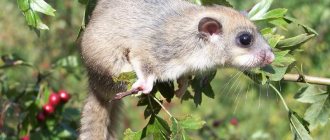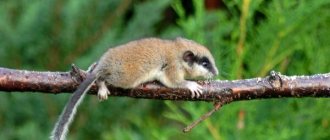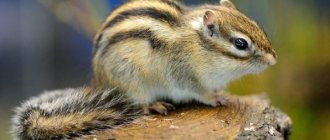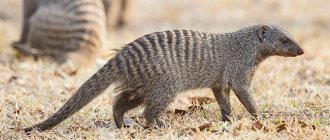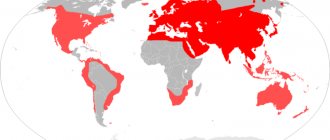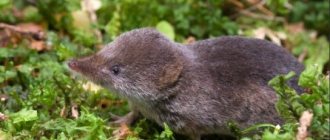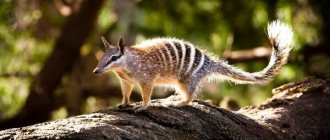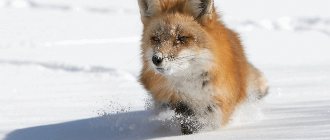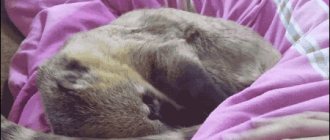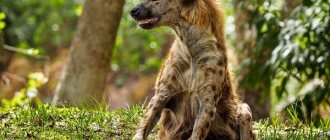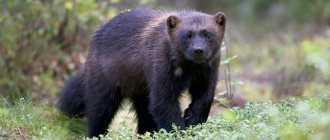- Wild animals
- >>
- Mammals
The hazel dormouse is simply a wonderful miniature creature, looking at which you can’t help but be touched; images of a perky hamster and a nimble squirrel immediately pop up in your mind. This red-haired beauty is a member of its own family of dormouse and is also called the flycatcher. Many have not even heard of such an animal, so it will be very interesting to learn more about its character and way of life.
Origin of the species and description
Photo: Hazel Dormouse
The hazel dormouse (bushcatcher) is a mammal belonging to the dormouse family and the order of rodents. Outwardly, it is very similar to a squirrel, only of reduced size, and its dimensions are similar to those of a mouse. Of its entire family, the hazel dormouse is the smallest.
The weight of an adult individual is only about 27 grams, the same weight as a well-fed dormouse about to hibernate. When the animal wakes up, its weight drops to 15–17 grams. The body length of the hazel dormouse is from 7 to 9 cm, not counting the tail, the length of which is about 6 or 7 cm.
Video: Hazel Dormouse
Of all the dormouse, be it a forest dormouse or a garden dormouse, the hazel dormouse is the most arboreal, i.e. The animal spends most of its time among tree branches, so it climbs them well. The limbs of the hazel dormouse are specially designed so that it can comfortably make its way through the dense crown. There are four fingers on the hand of the limb, the length of which is almost the same; the first toe on the foot is slightly smaller than the others and is perpendicular to them.
When moving and jumping in tree branches, the hands of the hazel dormouse turn almost ninety degrees.
It is worth noting that this unusual miniature animal can be tamed; the hazel dormouse can live at home, like an ordinary hamster or guinea pig. Only the owner needs to take into account the fact that it is a nocturnal animal. Still, there is no need to confuse the hazel dormouse with a squirrel or mouse, although it is also a rodent, but belongs to a separate family of dormouse.
Characteristics of a rodent
There are several types of them, but they are divided into two groups - terrestrial and arboreal. The arboreal ones resemble small ones, while the terrestrial ones are more like mice. All species adapt well to life in captivity, but there is an important requirement - frequent cleaning of the cage is necessary. Although these animals are small, they quickly pollute the home, causing unpleasant odors.
Sonya regiment
Characteristics of the animal:
- The nut dormouse (tree dormouse) has an orange coat, while the dormouse (terrestrial) has a gray coat. That's right, squirrel and mouse;
- Body length - up to 20 cm. Tail is approximately the same length;
- Weight – no more than 100 grams;
- Ears are round;
- Lifestyle – nocturnal;
- Life expectancy is no more than 5 years, but more often no more than 3.
Tree dormouse jump very deftly and are able to fly along treetops up to 10 meters.
Appearance and features
Photo: Animal hazel dormouse
Outwardly, the hazel dormouse is very cute and attractive. Its neat round head has a slightly pointed pink nose and prominent black eyes, like two large shiny beads. The ears of the mulecat are small and round. After observing the dormouse, you will notice that they move like locators, and each can turn in different directions.
One of the advantages of the hazel dormouse is its long whiskers (vibrissae), the length of which is comparable to the length of almost half the body of the dormouse. The end of each sensitive whisker is slightly curved. The animal has two dozen teeth; on the cheek teeth of the dormouse there is a pattern similar to a comb. The incisors of the moss trap are very sharp, because with them it can easily chew through strong nut shells.
The hazel dormouse has a unique skeletal ability that allows it to shrink vertically, so the animal can curl up into a tiny ball and slip into any tiny gap. The limbs of dormouse have great flexibility, which helps the animal move deftly in tree branches. The fur of the hazel dormouse is short, very pleasant and soft.
Fur color can be:
- brown;
- amber;
- terracotta;
- red;
- reddish-gray.
Typically the fur on the head, tail and back is a reddish hue, while the belly and inner sides of the limbs are creamy white. The very tip of the tail can be either brown or white. It should be noted that the tail of the hazel dormouse is not only long, but also quite fluffy. There may also be light spots on the breast.
The fur coat of young hazel dormouse has a dull, often grayish color.
Where does the hazel dormouse live?
Photo: Hazel dormouse Red Book
The habitat of hazel dormouse is quite extensive. The animal is a common inhabitant of Europe, with the exception of Spain and Portugal, settled in the south of Great Britain and Sweden, and is registered in the north of Turkey. In our country, the hazel dormouse lives in the forests of the Volga region, Ciscaucasia, Caucasus and Cis-Dnieper. It should be noted that in Russia this animal is rare because it is very small in number.
Hazel dormouse are sedentary animals with their own territories. The size of such an allotment for a female individual can occupy about half a hectare; for males, the plots are twice as large. Animals contact each other only during the mating season. An important element in the places where fly traps are located is a dense undergrowth, mainly of hazel; it is not for nothing that the dormouse was called hazel.
Dormouse can settle in rowan, rose hip, and viburnum thickets. The Mustard loves young oak, linden and ash groves. Orchards make an excellent home for miniature creatures. It is wrong to think that they harm fruit trees; dormouse, on the contrary, promote their pollination.
The hazel dormouse gives its preference to deciduous, mixed forests, and coniferous forests are not so attractive to it. The animal can be found near country and forest roads, on forest edges, and in mountainous areas, dormice do not go higher than two kilometers.
LIFESTYLE
The hazel dormouse is the most common European member of the dormouse family. It inhabits deciduous and mixed forests. Dormouse lives in thickets near roads and on the edges. Very often it settles on bush-covered hillsides and groves. The hazel dormouse is active at night, so it is not easy to see. Sonya has excellent hearing and large sparkling eyes. If you're lucky, you can find its nest in the thickets. It has a spherical shape, the diameter of the nest reaches 15-20 cm.
The nest is woven from blades of grass and leaves glued together with sticky saliva. Dormouse makes a nest in dense bushes or in low hollows at a height of 0.5-2 m from the ground, and sometimes in abandoned birdhouses.
What does the hazel dormouse eat?
Photo: Hazel Dormouse
The hazel dormouse menu is mostly vegetarian. It’s easy to guess that her favorite treat is nuts. The dormouse eats the most nuts in preparation for hibernation, when it gains weight, because the animal does not make any reserves for the winter. The nuts that the dormouse tried but did not eat can be distinguished because... the animal leaves smooth round holes from the teeth on their shell. Dormouses do not have a cecum in their body, so foods high in fiber are poorly digested. Animals prefer fruits and seeds.
In addition to nuts, the diet of rodents consists of:
- berries (strawberries, blueberries, raspberries, lingonberries, blackberries);
- acorns;
- fruit;
- young buds (in spring);
- shoots;
- seeds
It may seem unusual, but these tiny creatures do not refuse protein foods. Sonya happily eats worms and bird eggs if given the opportunity. In addition to worms, they do not disdain dormice and other insects. In spring, animals can eat the bark of young spruce trees. It is interesting to watch the dormouse during its meal, because it holds some fruit with its two front paws. This is how varied the menu is for this tiny rodent that lives in the crown of various trees and shrubs.
Features of character and lifestyle
Photo: Hazel dormouse animal
The hazel dormouse is a crepuscular animal that spends most of its life in the sleepy kingdom, which is why it has such an interesting name. Sonya sleeps not only during the daytime, but also from October to April, falling into hibernation, because she cannot tolerate low temperatures.
Even in summer, when the air temperature drops below 17 degrees, the dormouse falls into a kind of torpor and can sleep for several days until it gets warmer.
As already mentioned, dormouse are sedentary animals that occupy separate territories. The animals prefer to live alone, meeting each other during the mating season. At night, they actively search for food, deftly moving from branch to branch, and during daylight hours they sleep in their cozy nests.
Each dormouse on its plot of land has several daytime shelter nests, which are usually located in trees at a height of one to two meters. The flycatcher also has a winter hole, which it carefully arranges all summer so that it is warm for wintering.
If the dormouse herself participates in the construction of the nest, then she makes it from grass, moss, foliage, and small branches, which she connects with her sticky saliva. It must be said that the hazel dormouse can sometimes be impudent and unceremonious; the animal often occupies other people’s nests, driving out their owners: titmice, sparrows. Sonya can also live in a birdhouse, attic, hollow, or in an old car tire.
If we talk about the disposition and character of these small creatures, then we can say that dormouse are very curious and brave, very good-natured and easily make contact with people, the animals are very trusting, so they are not difficult to tame.
Some nuances of the content
When keeping these touching animals, the following must be taken into account:
- Like all wild animals, dormice smell. For allergy sufferers, odorous substances and wool can pose a certain threat.
- Dormouses are very nimble animals. It is quite difficult to catch an escaped rodent and put it back in the cage. Try to tame the animal first, otherwise you will catch it with your whole family within a week. And during this time she will make a nest for herself in your favorite slippers!
- If you want to get offspring, keep in mind that animals reproduce only after hibernation. Organize a dark place and a temperature of +5 during the winter period and, when you wake up, the couple will delight you with babies.
- Don't overindulge your sleepyhead with delicacies. Otherwise, it may turn out that in the absence of pine nuts and pineapples, she will suffer and go on hunger strike.
Social structure and reproduction
Photo: Hazel dormouse from the Red Book
Hazel dormouse are solitary animals that contact each other only during the mating season, which lasts throughout the summer, as long as it is warm. In order to make the babies comfortable, females make a maternity nest, which is much larger than usual. Its traps are placed at a low height relative to the ground. Such a nest consists of two layers: on top it is covered with leaves, and inside it is covered with down, feathers, and small grass.
Over the summer, a female can produce two broods, and if the heat persists for a long time and the summer period drags on, then three. Typically, the hazel dormouse gives birth to two to six babies. The gestation period lasts about 25 days, it is identical to the period of feeding the cubs. It has been noticed that dormouse are very caring towards their babies; if suddenly the mother dies, then another female can raise her babies. Among this species of rodents, a female has never been observed to eat her own offspring.
If it is cold and rainy in the summer, then the males are in no hurry to look for females for mating, they remain in their cozy nests, then the hazel dormouse does not reproduce.
As is typical for all rodents, baby dormouse are born completely helpless and blind; they have no fur. Only closer to the 18th day of age, the babies become similar to adult animals. At the age of forty days, small rodents already gain independence. Sometimes, when a female gives birth late, before the autumn cold, the babies remain to spend the winter with their mother.
Young animals become sexually mature when they are one year old. In wild, natural conditions, hazel dormouse live only about two to three years, but in captivity they can live up to eight. This difference in life expectancy occurs due to the fact that many animals in their natural habitat do not survive cold, harsh winters.
pet
The hazel dormouse is sociable, friendly and easily gets used to people. If the squirrel is too big for you and mice and rats don't seem like a good option, this is the best choice. The animal is active and curious. It has no special feeding requirements. When keeping a pair, there are no problems with uncontrolled reproduction; after all, these are not hamsters. Sonya is clean, smart and doesn't bite. The dormouse also has advantages in life expectancy in captivity. With careful care, they will be happy for up to 6 years, unlike other pet rodents.
Natural enemies of hazel dormouse
Photo: Hazel Dormouse
Despite the fact that the hazel dormouse is very tiny, it does not have particularly zealous enemies among other animals. None of the predators hunt specifically for this animal. They might come across Sonya completely by accident. So a rodent can become prey for an owl, wild cat, marten, fox, weasel. Sometimes it happens that the hole where the dormouse lives is torn apart by a fox or wild boar, but the animal can survive, because dormouse has great sensitivity and caution.
Nature has come up with an original protective mechanism for these tiny creatures, which consists in the fact that the skin from the dormouse’s tail flies off like a stocking if someone grabs the animal by this long part of its body. In such cases, the clever and resourceful dormouse successfully escapes from her ill-wisher. Of course, then the part of the tail that has no skin dies and falls off over time, but the rodent remains alive.
Unfortunately, one of the most dangerous enemies for hazel dormouse is man, who destroys the territories of their permanent settlement, cutting down forests and plowing up agricultural land. Musk traps also die from pesticides that people use to treat cultivated plants. This is how difficult the life of these tiny and vulnerable creatures living in the wild is.
Population and species status
Photo: Animals hazel dormouse
Scientists have noticed that the population size of the hazel dormouse, which lives in natural conditions, is gradually declining every year, which is very alarming. This process is more intensely observed in the northern regions of the habitat of this interesting animal. It should be noted that throughout the entire range the number of hazel dormouse is not at all numerous.
So far, the hazel dormouse population has not reached a critical level. Currently, this species of rodent is classified as one of the species with the least threat to its habitat, but in the lists of international environmental organizations, muskie traps are given a special status.
The situation with the population size of the hazel dormouse is not the same in all regions; in some territories this animal is considered very rare and is listed in the Red Book. As sad as it is to realize this, such a situation has developed in our country, where this miniature rodent is very few in number.
Great damage to the population is caused not only by humans, but also by harsh winters, which not every animal can survive. There is evidence that about 70 percent of flycatchers do not survive severe frosts and die directly during hibernation. It is not easy for such a baby to survive in harsh winter climatic conditions.
